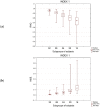The Sample Size Matters: To What Extent the Participant Reduction Affects the Outcomes of a Neuroscientific Research. A Case-Study in Neuromarketing Field
- PMID: 34577294
- PMCID: PMC8473095
- DOI: 10.3390/s21186088
The Sample Size Matters: To What Extent the Participant Reduction Affects the Outcomes of a Neuroscientific Research. A Case-Study in Neuromarketing Field
Abstract
The sample size is a crucial concern in scientific research and even more in behavioural neurosciences, where besides the best practice it is not always possible to reach large experimental samples. In this study we investigated how the outcomes of research change in response to sample size reduction. Three indices computed during a task involving the observations of four videos were considered in the analysis, two related to the brain electroencephalographic (EEG) activity and one to autonomic physiological measures, i.e., heart rate and skin conductance. The modifications of these indices were investigated considering five subgroups of sample size (32, 28, 24, 20, 16), each subgroup consisting of 630 different combinations made by bootstrapping n (n = sample size) out of 36 subjects, with respect to the total population (i.e., 36 subjects). The correlation analysis, the mean squared error (MSE), and the standard deviation (STD) of the indexes were studied at the participant reduction and three factors of influence were considered in the analysis: the type of index, the task, and its duration (time length). The findings showed a significant decrease of the correlation associated to the participant reduction as well as a significant increase of MSE and STD (p < 0.05). A threshold of subjects for which the outcomes remained significant and comparable was pointed out. The effects were to some extents sensitive to all the investigated variables, but the main effect was due to the task length. Therefore, the minimum threshold of subjects for which the outcomes were comparable increased at the reduction of the spot duration.
Keywords: EEG; GSR; HR; applied neurosciences; sample size; signal processing.
Conflict of interest statement
The authors declare no conflict of interest.
Figures





Similar articles
-
Small class sizes for improving student achievement in primary and secondary schools: a systematic review.Campbell Syst Rev. 2018 Oct 11;14(1):1-107. doi: 10.4073/csr.2018.10. eCollection 2018. Campbell Syst Rev. 2018. PMID: 37131395 Free PMC article.
-
Neurophysiological tools to investigate consumer's gender differences during the observation of TV commercials.Comput Math Methods Med. 2014;2014:912981. doi: 10.1155/2014/912981. Epub 2014 Jul 23. Comput Math Methods Med. 2014. PMID: 25147579 Free PMC article.
-
Subgroup analyses in randomised controlled trials: quantifying the risks of false-positives and false-negatives.Health Technol Assess. 2001;5(33):1-56. doi: 10.3310/hta5330. Health Technol Assess. 2001. PMID: 11701102 Review.
-
A gateway to consumers' minds: Achievements, caveats, and prospects of electroencephalography-based prediction in neuromarketing.Wiley Interdiscip Rev Cogn Sci. 2019 Mar;10(2):e1485. doi: 10.1002/wcs.1485. Epub 2018 Nov 29. Wiley Interdiscip Rev Cogn Sci. 2019. PMID: 30496636 Review.
-
Changes in brain activity during the observation of TV commercials by using EEG, GSR and HR measurements.Brain Topogr. 2010 Jun;23(2):165-79. doi: 10.1007/s10548-009-0127-0. Epub 2009 Dec 22. Brain Topogr. 2010. PMID: 20033272
Cited by
-
Neuroscientific Methods for Exploring User Perceptions While Dealing With Mobile Advertising: A Novel and Integrated Approach.Front Neuroergon. 2022 Apr 8;3:835648. doi: 10.3389/fnrgo.2022.835648. eCollection 2022. Front Neuroergon. 2022. PMID: 38235455 Free PMC article.
-
Distinct Effects of the Apolipoprotein E ε4 Genotype on Associations Between Delayed Recall Performance and Resting-State Electroencephalography Theta Power in Elderly People Without Dementia.Front Aging Neurosci. 2022 May 26;14:830149. doi: 10.3389/fnagi.2022.830149. eCollection 2022. Front Aging Neurosci. 2022. PMID: 35693343 Free PMC article.
-
Sensory modality defines the relation between EEG Lempel-Ziv diversity and meaningfulness of a stimulus.Sci Rep. 2023 Mar 1;13(1):3453. doi: 10.1038/s41598-023-30639-3. Sci Rep. 2023. PMID: 36859725 Free PMC article.
-
Listening Effort in Tinnitus: A Pilot Study Employing a Light EEG Headset and Skin Conductance Assessment during the Listening to a Continuous Speech Stimulus under Different SNR Conditions.Brain Sci. 2023 Jul 17;13(7):1084. doi: 10.3390/brainsci13071084. Brain Sci. 2023. PMID: 37509014 Free PMC article.
-
A Neuroergonomic Approach Fostered by Wearable EEG for the Multimodal Assessment of Drivers Trainees.Sensors (Basel). 2023 Oct 11;23(20):8389. doi: 10.3390/s23208389. Sensors (Basel). 2023. PMID: 37896483 Free PMC article.
References
-
- Sanders N., Choo S., Nam C.S. Cognitive Science and Technology. Springer; Berlin, Germany: 2020. The EEG cookbook: A practical guide to neuroergonomics research; pp. 33–51.
-
- Mao Z., Jung T.P., Lin C.T., Huang Y. Predicting EEG sample size required for classification calibration; Proceedings of the Foundations of Augmented Cognition: Neuroergonomics and Operational Neuroscience—AC 2016; Toronto, ON, Canada. 17–22 July 2016; Cham, Switzerland: Springer; 2016. pp. 57–68. Lecture Notes in Computer Science (Including Subseries Lecture Notes in Artificial Intelligence and Lecture Notes in Bioinformatics) - DOI
MeSH terms
Grants and funding
- 826232/WORKINGAGE: Smart Working environments for all Ages
- 723386/SIMUSAFE: Simulator Of Behavioral Aspects For Safer Transport
- 814961/SAFEMODE: Strengthening synergies between Aviation and maritime in the area of human Factors towards achieving more Efficient and resilient MODE of transportation
- 950998/MINDTOOTH: Wearable device to decode human mind by neurometrics for a new concept of smart interaction with the surrounding environment
- 894238/Transparent artificial intelligence and automation to air traffic management systems, ''ARTIMATION,''
LinkOut - more resources
Full Text Sources
Research Materials

